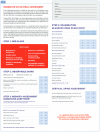Sport-Related Concussion: Evaluation, Treatment, and Future Directions
- PMID: 30884753
- PMCID: PMC6473667
- DOI: 10.3390/medsci7030044
Sport-Related Concussion: Evaluation, Treatment, and Future Directions
Abstract
Sport-related concussion (SRC) is a highly prevalent injury predominantly affecting millions of youth through high school athletes every year. In recent years, SRC has received a significant amount of attention due to potential for long-term neurologic sequelae. However, the acute symptoms and possibility of prolonged recovery account for the vast majority of morbidity from SRC. Modifying factors have been identified and may allow for improved prediction of a protracted course. Potential novel modifying factors may include genetic determinants of recovery, as well as radiographic biomarkers, which represent burgeoning subfields in SRC research. Helmet design and understanding the biomechanical stressors on the brain that lead to concussion also represent active areas of research. This narrative review provides a general synopsis of SRC, including relevant definitions, current treatment paradigms, and modifying factors for recovery, in addition to novel areas of research and future directions for SRC research.
Keywords: biomechanics; genetics; mild traumatic brain injury; neuroimaging; sport-related concussion.
Conflict of interest statement
G.S. has served as a member of the senior advisory board for ImPACT and is a senior advisor in the National Football League’s Department of Health and Safety. N.H., L.M., A.M.Y-K., and S.L.Z. report no conflict of interest.
Figures
References
Publication types
LinkOut - more resources
Full Text Sources
Miscellaneous


